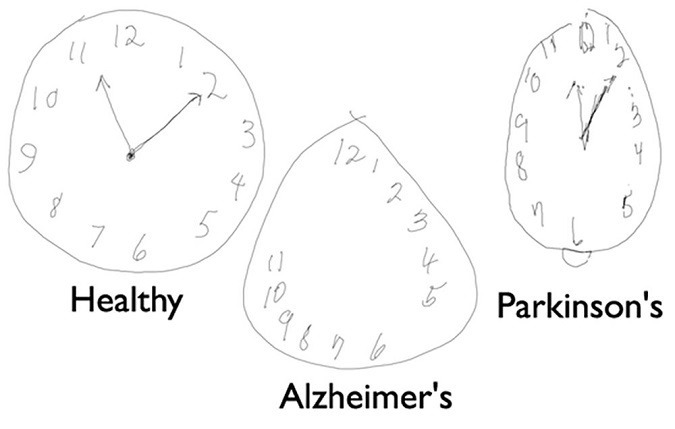On the value and the limits of cognitive screening, as seen in President Trump’s examination

Example clocks, courtesy of William Souillard-Mandar et al (2015)
In the News:
Why you may be misunderstanding the mental test that Trump passed with flying colors (The Washington Post):
“On its surface, the Montreal Cognitive Assessment (MoCA) test seems pretty easy. Can you draw a three-dimensional cube? Can you identify these various animals? Can you draw a clock? Can you repeat back the phrase, “The cat always hid under the couch when dogs were in the room”?…The point is not that the test is easy. The point is that an inability to complete aspects of the test reveals different types of mental decline. The clock test is about executive brain function: memory, planning ahead. The different parts of the MoCA are labeled according to what they test, with the clock test falling under “visuospatial/executive.” Questions about the current year and date are under “orientation.” The request to identify a drawing of a camel is under “naming.” In the test’s scoring instructions, it explains what is covered: “attention and concentration, executive functions, memory, language, visuoconstructional skills, conceptual thinking, calculations and orientation.”
It is, as Trump’s doctor noted, a tool for identifying early signs of mental deterioration, like the mental version of a blood sample on which your doctor runs a battery of tests. It’s not the SAT; it’s a screening device…
Yes, Trump passed with flying colors, as any adult with normal cognitive function probably would. And that’s the point…You’re supposed to get 30 out of 30 — and when you don’t, that’s when the doctors learn something.”
In clinical practice: Comparing 2 common cognitive screening tools
TESTING FOR DEMENTIA: THE MONTREAL COGNITIVE ASSESSMENT (MOCA) (DailyCaring):
“How are the MoCA and MMSE different?
The MoCA looks similar to the MMSE, but the MoCA tests a variety of different cognitive functions and the MMSE focuses mostly on memory and recall.
The MoCA is generally better at detecting mild impairment and early Alzheimer’s disease because it’s a more sensitive test and is more difficult. So, if a doctor sees a patient who is questioning their mental functioning, they might give the MoCA. But if a patient comes in and is clearly cognitively impaired, a very sensitive test wouldn’t be as necessary since the issues are more obvious.
The MoCA has also been shown to be a better screening tool for conditions like:
- Parkinson’s disease
- Vascular dementia
- Traumatic brain injury (often from falls)
- Huntington’s disease
- Brain tumors
- Multiple sclerosis
How are the MoCA and MMSE similar?
Even though these are good screening tools for cognitive impairments, neither test was designed to diagnose cognitive conditions.
They also can’t be used to distinguish between conditions. For example, you couldn’t use either test to diagnose someone with Alzheimer’s versus frontotemporal dementia. After the initial screening, more testing would be needed.”
In the scientific literature:
Trajectory and variability characterization of the Montreal cognitive assessment in older adults. (Aging Clinical and Experimental Research). From the abstract:
- BACKGROUND: The Montreal cognitive assessment (MoCA) has become one of the most widely used cognitive screening instruments since its initial publication. To date, only a handful of studies have explored longitudinal characteristics of the MoCA.
- AIM: The aim of this study is to characterize the trajectory of MoCA performance across a broad age continuum of older adults.
- METHODS: Data from 467 cognitively normal participants were used in this analysis. The sample was grouped into four strata based on the participants’ age at baseline (60–69, 70–79, 80–89, and 90–99). Mixed model repeated measures (MMRM) analysis and mixed-effects spline models were used to characterize the trajectory of MoCA scores in each age stratum and in the entire sample. Intrasubject standard deviation (ISD) was used to characterize the natural variability of individual MoCA performance over time.
- RESULTS: The ISD (Note: Intrasubject Standard Deviation) values for each of the age strata indicated that year-to-year individual variation on the MoCA ranged from zero to three points. MMRM analysis showed that the 60–69 stratum remained relatively stable over time while the 70–79 and 80–89 strata both showed notable decline relative to baseline performance. The mixed-effects spline model showed that MoCA performance declines linearly across the older adult age span.
- DISCUSSION: Among cognitively normal older adults MoCA performance remains relatively stable over time, however across the older adult age-span MoCA performance declines in a linear fashion. These results will help clinicians better understand the normal course of MoCA change in older adults while researchers may use these results to inform sample size estimates for intervention studies.
Cognitive monitoring and testing in the near future:
- The FDA clears two computerized cognitive tests to assist in medical evaluations following brain injury or concussion
- Biopharma embraces digital cognitive assessments to identify behavioral health biomarkers
- Five reasons the future of brain enhancement is digital, pervasive and (hopefully) bright
- 10 neurotechnologies about to transform brain enhancement and brain health
- Jan Samzelius, CEO of Brainnovations Winner NeuraMetrix, encourages pioneers to focus on “simple, elegant solutions to big problems”


